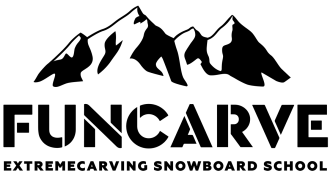Carving technique. Body Rotation
Rotation is a way to change edges in which in the middle of the turn your body is twisted inside the turn. It is the most natural and comfortable position for carving because deflections of the basic position are minimum.
The purport of rotation as a movement lies in partial unweight of the snowboard in the process of changing the edge and that facilitates edge transferring without harsh change in trajectory of motion. Also rotation allows you to control the board more smoothly and quickly because after changing the edge your board follows its radius providing a secure cohesion between the edge and the slope from the very beginning of the turn.
To study this technique in details we will divide it into two parts – frontside and backside. Pay attention to the fact that in the moments of edge changing you will be in basic position in both of these parts of the turn and it means that both parts of the turn we are talking about will start with basic position. In addition you need to remember about terms ‘plus’, ‘minus’ and ‘half-plus’.
Frontside turn
In the very beginning of the carve your body is in basic position, in ‘half-plus’. While you make your turn you need to twist your body smoothly and tensely inside the turn starting with your knees and finishing with your shoulder. In the end of the turn but still on the frontside your shoulders should be almost in ‘minus’ position, your head is directed forward, you look above your shoulder towards the direction of your board motion, both hands are inside the turn placed on your thighs. In the moment of edge transferring your shoulders return to ‘half-plus’ position smoothly but quickly.
Backside turn
In the beginning of the carve your body has ‘half-plus’ position and while you make the turn your body is twisting more inside the turn towards the leading leg. In the end of the carve but still on the backside your body has ‘plus’ position, your head is directed up and forward, the leading hand is pressed to the leading knee at its left, your back hand is reaching forward for your forearm according to the direction of the board motion.
Note that in rotation your body is like trying to catch the board that is making the turn and in every moment till the fall line a rider is in basic position. In the moment of edge transferring the shoulders return to ‘half-plus’ position smoothly but quickly.
Typical mistakes
- Counter twisting of the body on the frontside.
Because of fear or a habit most snowboarders always tend to look down the slope but this desire is purely intuitive. In fact the danger comes from behind and you should always avoid people that are above you. Besides counter twisting breaks your turn earlier than needed which results in increasing of speed and decreasing of control. - Not enough twist of shoulders\hips on backside
Often a snowboarder is sure that they do it well. Be attentive to the opinion of others. It will help you to twist shoulders properly if you focus on shoulders; you will feel them better if you keep your hands clasped to your body. Actually amplitude movements always look great on the slope; - Overload of the board nose in backside
This happens due to the same reflex that makes us transfer the weight to the leg to which we turn. It is necessary to keep it in mind always and to compensate it by shifting your hips back along the board; - Harsh or early turn of the shoulders to the maximum.
Often a snowboarder tries to twist their body inside the turn so much that they do it too quickly by turning their shoulders to the maximum already in the beginning of the carve. It leads (as all harsh movements) to decreased loading of the board and unbalanced basic position. You should keep in mind that you need to twist your body to the side of the turn progressively as you do the carve and you should chose the depth of your twist according to your speed; - Mistaken excessive twisting.
Some carvers think that if you have already twisted your body in the turn it is a good idea to twist it even more. This clumsy way to keep the balance instead of feeling delicately each centimeter of your board leads to unbalance and discomfort;




